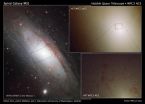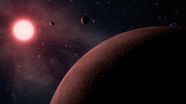(Press-News.org) Peering deep inside the hub of the neighboring Andromeda galaxy, NASA's Hubble Space Telescope has uncovered a large, rare population of hot, bright stars.
Blue is typically an indicator of hot, young stars. In this case, however, the stellar oddities are aging, sun-like stars that have prematurely cast off their outer layers of material, exposing their extremely blue-hot cores.
Astronomers were surprised when they spotted these stars because physical models show that only an unusual type of old star can be as hot and as bright in ultraviolet light.
While Hubble has spied these ultra-blue stars before in Andromeda, the new observation covers a much broader area, revealing that these stellar misfits are scattered throughout the galaxy's bustling center. Astronomers used Hubble's Wide Field Camera 3 to find roughly 8,000 of the ultra-blue stars in a stellar census made in ultraviolet light, which traces the glow of the hottest stars. The study is part of the multi-year Panchromatic Hubble Andromeda Treasury survey to map stellar populations across the galaxy.
"We were not looking for these stars. They stood out because they were bright in ultraviolet light and very different from the stars we expected to see," said Julianne Dalcanton of the University of Washington in Seattle, leader of the Hubble survey.
The team's results are being presented today at the American Astronomical Society meeting in Austin, Texas. A paper describing the finding will be published in The Astrophysical Journal.
The telescope spied the stars within 2,600 light-years of the core. After analyzing the stars for nearly a year, Dalcanton's team determined that they were well past their prime. "The stars are dimmer and have a range of surface temperatures different from the extremely bright stars we see in the star-forming regions of Andromeda," said Phil Rosenfield of the University of Washington, the paper's lead author.
As these stars evolved, puffing up to become red giants, they ejected most of their outer layers to expose their blue-hot cores. When normal sun-like stars swell up to become red giants, they lose much less material and therefore never look as bright in the ultraviolet.
"We caught these stars when they're the brightest, just before they become white dwarfs," said team member Leo Girardi of the National Institute for Astrophysics's Astronomical Observatory of Padua. "It is likely that there are many other similarly hot stars in this central part of Andromeda at earlier stages of their lives. But such stars are too dim for Hubble to see because they're mixed in with a crowd of normal stars."
The astronomers have proposed two possible scenarios to explain why these blue stars evolve differently. According to Rosenfield, the most likely scenario is that the stars are rich in chemical elements other than hydrogen and helium. Observations with ground-based telescopes have shown the stars in the galaxy's hub have an abundant supply of "heavy elements," which makes it easier for stars to eject lots of material into space late in life.
In this scenario radiation from the star is more efficient at pushing on gas laced with heavy elements, which drives away the material, like wind moving a thick sail. Although all the stars in the core are enriched in heavy elements, the bright blue stars may contain especially high amounts, which help trigger the mass loss.
The study also shows that the number of blue stars decreases with distance from the core, tracing the drop in the amount of heavy elements.
Another possible explanation is that the blue stars are in close binary systems and have lost mass to their partners. This mass loss would expose the stars' hot cores. The astronomers were surprised to find that the ultra-blue stars are distributed in the galaxy in the same way as a population of binary stars with similar masses that were found in X-ray observations by NASA's Chandra X-ray Observatory.
INFORMATION:
The astronomers' next step is to create simulations of these stars to try to determine which scenario is the one that leads them on a different evolutionary path.
The Hubble Space Telescope is a project of international cooperation between NASA and the European Space Agency. NASA's Goddard Space Flight Center manages the telescope. The Space Telescope Science Institute (STScI) conducts Hubble science operations. STScI is operated for NASA by the Association of Universities for Research in Astronomy, Inc., in Washington, D.C.
For images and more information about this study, visit:
http://hubblesite.org/news/2012/03
Rare ultra-blue stars found in neighboring galaxy's hub
2012-01-13
ELSE PRESS RELEASES FROM THIS DATE:
Hubble zooms in on double nucleus in Andromeda galaxy
2012-01-13
A new Hubble Space Telescope image centers on the 100-million-solar-mass black hole at the hub of the neighboring spiral galaxy M31, or the Andromeda galaxy, the only galaxy outside the Milky Way visible to the naked eye and the only other giant galaxy in the local group.
This is the sharpest visible-light image ever made of the nucleus of an external galaxy.
The event horizon, the closest region around the black hole where light can still escape, is too small to be seen, but it lies near the middle of a compact cluster of blue stars at the center of the image. The ...
People mimic each other, but we aren't chameleons
2012-01-13
It's easy to pick up on the movements that other people make—scratching your head, crossing your legs. But a new study published in Psychological Science, a journal of the Association for Psychological Science, finds that people only feel the urge to mimic each other when they have the same goal.
It's common for people to pick up on each other's movements. "This is the notion that when you're having a conversation with somebody and you don't care where your hands are, and the other person scratches their head, you scratch your head," says Sasha Ondobaka of the Donders ...
A diet rich in slowly digested carbs reduces markers of inflammation in overweight and obese adults
2012-01-13
SEATTLE – Among overweight and obese adults, a diet rich in slowly digested carbohydrates, such as whole grains, legumes and other high-fiber foods, significantly reduces markers of inflammation associated with chronic disease, according to a new study by Fred Hutchinson Cancer Research Center. Such a "low-glycemic-load" diet, which does not cause blood-glucose levels to spike, also increases a hormone that helps regulate the metabolism of fat and sugar. These findings are published online ahead of the February print issue of the Journal of Nutrition.
The controlled, ...
Astronomers find 3 smallest planets outside solar system
2012-01-13
PASADENA, Calif. -- A team of astronomers led by scientists at the California Institute of Technology (Caltech) has discovered the three smallest confirmed planets ever detected outside our solar system. The three planets, which all orbit a single star, are smaller than Earth and appear to be rocky with a solid surface. Until now, astronomers have found at most only four other rocky planets, also called terrestrial planets, around other stars.
The trio of new planets is too close to the central star to be in its habitable zone—the ring-shaped region around a star where ...
Hubble solves mystery on source of supernova in nearby galaxy
2012-01-13
Using NASA's Hubble Space Telescope, astronomers have solved a longstanding mystery on the type of star, or so-called progenitor, which caused a supernova seen in a nearby galaxy. The finding yields new observational data for pinpointing one of several scenarios that trigger such outbursts.
Based on previous observations from ground-based telescopes, astronomers knew the supernova class, called a Type Ia, created a remnant named SNR 0509-67.5, which lies 170,000 light-years away in the Large Magellanic Cloud galaxy.
Theoretically, this kind of supernova explosion is ...
New information on the waste-disposal units of living cells
2012-01-13
Important new information on one of the most critical protein machines in living cells has been reported by a team of researchers with the U.S. Department of Energy's Lawrence Berkeley National Laboratory (Berkeley Lab) and the University of California (UC) Berkeley. The researchers have provided the most detailed look ever at the "regulatory particle" used by the protein machines known as proteasomes to identify and degrade proteins that have been marked for destruction. The activities controlled by this regulatory particle are critical to the quality control of cellular ...
A clue to the GI problems that plague many kids with autism?
2012-01-13
January 11, 2012 -- New research conducted in the Center for Infection and Immunity (CII) at Columbia University's Mailman School of Public Health, reports that children with autism and gastrointestinal disturbances have high levels of a bacterium called Sutterella in their intestines.
Study findings are published online in the journal mBio.
The investigators found that over half of the children diagnosed with autism and gastrointestinal disturbances had Sutterella in intestinal biopsy tissue, while Sutterella was absent in biopsies from typically developing children ...
Treatment with light benefits Alzheimer's patients, Wayne State University finds
2012-01-13
Detroit - Exposure to light appears to have therapeutic effects on Alzheimer's disease patients, a Wayne State University researcher has found.
In a study published recently in the Western Journal of Nursing Research, LuAnn Nowak Etcher, Ph.D., assistant professor of nursing, reported that patients treated with blue-green light were perceived by their caregivers as having improved global functioning.
Caregivers said patients receiving the treatment seemed more awake and alert, were more verbally competent and showed improved recognition, recollection and motor coordination. ...
Rice's 'quantum critical' theory gets experimental boost
2012-01-13
New evidence this week supports a theory developed five years ago at Rice University to explain the electrical properties of several classes of materials -- including unconventional superconductors -- that have long vexed physicists.
The findings in this week's issue of Nature Materials uphold a theory first offered in 2006 by physicist Qimiao Si, Rice's Harry C. and Olga K. Wiess Professor of Physics and Astronomy. They represent an important step toward the ultimate goal of creating a unified theoretical description of the quantum behavior of high-temperature superconductors ...
ISG15: A novel therapeutic target to slow breast cancer cell motility
2012-01-13
Interferon-stimulated gene 15 (ISG15), a ubiquitin like protein, is highly elevated in a variety of cancers including breast cancer. How the elevated ISG15 pathway contributes to tumorigenic phenotypes remains unclear and is the subject of a study published in the January 2012 issue of Experimental Biology and Medicine. Dr. Shyamal Desai and her co-investigators from the Louisiana State University School of Medicine in New Orleans, the University of Pennsylvania School of Medicine in Philadelphia, and the Robert Wood Johnson School of Medicine in New Jersey report that ...




